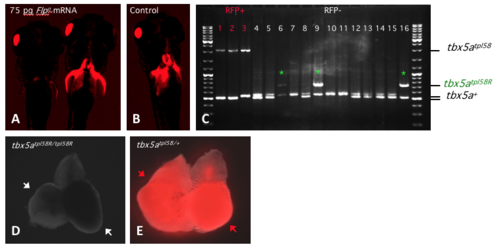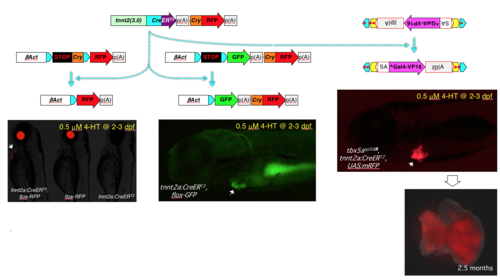- Title
-
Analysis of a conditional gene trap reveals that tbx5a is required for heart regeneration in zebrafish
- Authors
- Grajevskaja, V., Camerota, D., Bellipanni, G., Balciuniene, J., Balciunas, D.
- Source
- Full text @ PLoS One

ZFIN is incorporating published figure images and captions as part of an ongoing project. Figures from some publications have not yet been curated, or are not available for display because of copyright restrictions. EXPRESSION / LABELING:
|
|
tbx5atpl58 mutant phenotypes. A-D. Larvae heterozygous for tbx5atpl58 gene trap allele display severe but variable fin defects at 5 days post fertilization. Compared to wild type siblings (a), heterozygous mutants display bilaterally equal fin truncation (b), or unequal fin truncation with left (c) or right (d) pectoral fin more severely affected. E. Gene trap homozygotes display a phenotype similar to the more severe version of heartstrings phenotype described previously (Fig 1D and 1E in Garrity et al., 2002). F-H. All adults heterozygous for the gene trap had hearts with enlarged atria and mis-shapen (blunt) ventricles (n = 13). a, atrium, v, ventricle, ba, bulbus arteriosus. PHENOTYPE:
|
|
Cardiomyocytes heterozygous for tbx5atpl58 contribute to the adult heart but lead to impaired regeneration. Top, experimental outline. A-F. Representative images of adjacent sections (A and B, C and D, E and F) of hearts (n = 7) stained for DAPI (A, C, E) and by Pico-Mallory stain (B, D, F). |
|
Loss of tbx5a in adult zebrafish leads to severe regeneration defects. Top, experimental outline. Bottom, sections of zebrafish hearts stained by Picro-Mallory stain. A-G. Hearts of zebrafish (n = 7) homozygous for the reverted tbx5a allele, and heterozygous for tnnt2:CreERT2, treated with ethanol (solvent for 4-HT). H, I. Hearts of zebrafish (n = 2) heterozygous for the reverted tbx5a allele, and heterozygous for tnnt2:CreERT2, treated with 4-HT. J-Q. Hearts of zebrafish (n = 8) homozygous for the reverted tbx5a allele, and heterozygous for tnnt2:CreERT2, treated with 4-HT. PHENOTYPE:
|
|
Reversion of tbx5atpl58 mutant phenotypes by inverting the gene trap cassette. A, B. Embryos injected with Flpo mRNA (A) highly reduced mRFP expression (left) and/or recovery of pectoral fins (right) compared to un-injected siblings (B). C. Screening of R1 (F1) embryos for a reverted allele (tbx5atpl58R) by three primer PCR. Embryos in the first three lanes were RFP positive and therefore were expected to carry the non-modified allele (tbx5atpl58). Embryos in lanes 4–16 were RFP negative and therefore were expected to be either wild-type (tbx5a+) or positive for the inverted allele (tbx5atpl58R). D. Fish homozygous for the reverted allele have normal hearts, compared to fish heterozygous for the gene trap. E. Enlarged atrium and blunt, mis-shapen ventricle comparable to the one shown in Fig 2 are indicated by red arrows. |
|
Tamoxifen-dependent and heart-specific tg(tnnt2:CreERT2)tpl48 driver can re-mutate tbx5atpl58R cardiomyocytes, which are then retained in adult hearts. Top, diagram of the miniTol2/tnnt2:CreERT2; crygc:mRFP) transgene. Left, diagram of a Cre-inducible mRFP (flox-mRFP) reporter and heart-specific mRFP expression in 4-HT-treated double transgenic fish. Middle panel, Cre-inducible GFP reporter (flox-GFP) and heart-specific GFP expression in double transgenic fish treated with 4-HT. Right, re-mutation of the gene trap in the cardiomyocytes at 3 dpf. Right bottom, heart of an adult fish which was treated with 4-HT between 2–3 dpf displays mosaic mRFP expression in the atrium and the ventricle, indicating mosaicism for tbx5atpl58 gene trap re-mutation. |


